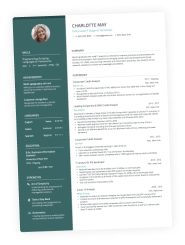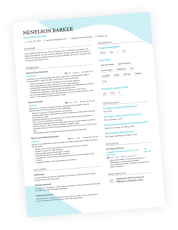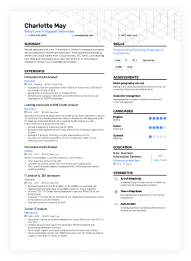You are a fresh graduate, or you want to try balancing between your education and work.
These are both great, but in order to get a job you need one really important thing – a good CV.
But how to write one when you have never done this before?
We got you covered.
In this article, we are going to explore all the important questions you need to know the answers to in order to get this right:
- What is a CV?
- What sections does your CV for first job need?
Along the way, we are going to give you some great examples of everything you need to know, and we will wrap things up with some great tips and tricks and one final complete example of what your CV for first job should look like.
When you have no experience in writing a CV, or even if you have some already, a great tool to get you going is our CV Builder that can give you a great design to impress any hiring manager.
So, if you are ready to get started with your CV for first job, let’s get started.
Is your CV good enough?
Drop your CV here or choose a file. PDF & DOCX only. Max 2MB file size.
What is a CV?
In simple words, a CV is a formal document that a job applicant creates to itemize their qualifications for a position. It usually includes work experience, education, skills and any other relevant information you want to share with your future employer. But we are going to go deeper in all that later on.
The goal of your CV is to quickly and effectively show your potential employer why you are uniquely qualified for their job opening, based on your relevant experience and skills.
No matter whether you're writing a CV for a job, or for applying for a federal or academic position, it is the most important document in your job application, followed by the cover letter.
Formats for your CV for first job?
Before you go any further, you need to be sure you are using the best format for your CV.
And to do so, you first need to know which are the most common ones and what are their differences.
We are going to go through them one by one.
Reverse Chronological Format
The Reverse Chronological Format is the most common out there.
That’s because it is suitable for pretty much every job position.
This format is mostly career-oriented – it lists your work history in order, as the most recent position would be at the top.
It is the ideal format for people with lots of work experience, relevant to the job position they are applying for.
As it is so career-oriented, it would not be the best fit for you, but we have two more formats for you to check out.
Functional Format
Your second alternative is pretty much the opposite of the Reverse Chronological Format.
The Functional Format is also called Skill-Based Format.
And yes, you guessed correctly, it focuses mainly on your skills.
It is the perfect choice for you if you are looking for your first job.
The great thing about the functional format is that it groups your skills in categories and presents them in a great and easy-to-read format.
We highly recommend reading a bit more about that format, as it just might be the right one for you – Fucntional Format.
But wait, not so fast, we have one more format for you, at it might turn out to be better for your needs after all.
Hybrid Format
The Hybrid Format is the perfect combination of the two formats listed above.
It takes all the best features from both formats.
It includes both Reverse Chronological Work History, and a highly detailed Skills Section.
It’s mostly used for job positions that require expertise in a variety of fields, and you want to show that you are the right person for the job.
Which Format to Choose for CV for first job?
Now, on to the main question – which format should you choose?
There is no easy answer to that question.
You have two good options – Hybrid or Functional format.
The Functional format would bring up your skills, and it is a better option when you have no work experience.
But if you have completed some internships, have done any volunteer work, or have some personal projects you can show off, the Hybrid format may give you a great chance to do so.
Whatever format you choose, you need to make sure it is easy-to-read.
Hiring managers receive hundreds of applications for every position, and can’t really afford to spend too much time on any.
On average, hiring managers would spend about 6-7 seconds on your CV.
That’s why, if it is not in an easy-to-read format, they might even skip it.
Sections your CV for first job needs +Examples
Your CV is all about selling yourself to the hiring manager. They need to understand who you are as a professional and see you as the right guy for the job.
To do so, you will need to populate your CV with the most important sections that every CV should have:
- Header
- Summary
- Work experience
- Skills
- Education
- Certifications (if any)
Of course, you can always add in any additional sections you think might increase your chances of getting the job. But be careful, you would not want your CV to exceed one page.
So let’s get a little deeper in each section your CV needs.
Header
Nowadays, there are more and more candidates for each and every job position out there, which makes it impossible for hiring managers to look carefully through all the CVs.
You need to grab their attention at the very beginning of your CV – the header, and make them keep reading until the end.
Of course, you can’t get the job with just your header, but it is a key moment for even being considered.
A great header should consist of three important parts:
- Your full name
- Job title (if you have one from internships)
- Contact information (including your email, phone number, address, LinkedIn profile, and portfolio, if you have one)
But you can’t just throw them in your CV, they should follow specific standards in order to look professional.
Let’s start with your full name – you would want it to have the largest font size of your entire CV. It is your initial introduction with the hiring manager, and you would not want them to lose track of who you are.
When it comes to the job title, don’t worry if you have one – it is after all your first job. But if you have finished some internship that is relevant to the job position, you would want to take advantage of that and put it right underneath your full name.
And now, the most complex part of your header – the contact information. We are going to break this into pieces, so that you don’t lose track.
Email address
Your email address is likely to be the preferred method of communication by the hiring manager when they initially contact you.
It is crucial for your job application to make your email address look professional. An email address that seemed funny in college is not the right email address for the job.
Your best option is to use a provider like Gmail, Outlook, or iCloud, and keep a format that includes your name, like “firstname.lastname@domain.com” .
Phone number
That is the second must that you should not exclude from your contact information. It is just as important a means of communication, as your email address.
Make sure you list your personal cell phone, so that you would be sure that the hiring manager would reach you.
Keep only one phone number on your CV. Any more than that might come off confusing and would be more difficult to keep track of.
Address
With “work from home” becoming the most preferred way to work nowadays, you don’t really need to include your address in your CV anymore.
There are however some reasons for some employers to prefer local candidates, including:
- Tax purposes
- Traveling time in case you have the option to work from an office
However, if you decide to include your address, make sure you only list city and state.
Any more information is too much, and can even be harmful to you, if your CV ends up in the wrong hands.
LinkedIn profile
If you don’t have to have a LinkedIn profile, it wouldn’t hurt you to make an account.
It can usually serve you really well, as hiring managers would definitely want to learn more about you than you can list on your one-page CV.
And if you don’t have a profile yet, there is no better time to create one.
Portfolio
If you are applying for a creative position, a website that showcases your portfolio, work achievements and skills, can really be a great addition to your CV.
Another great reason for including a personal website is if you are trying to make it as a web developer, as that would be a great proof of your talents.
That’s pretty much all you need to know about your header, so let’s take a look at what should it look like when you are finished:
Summary
Now you have your header ready to go, and it is time to really hook the hiring manager in with your summary.
That section has the goal to present who you are and show both your goals at the new company, and your greatest assets and accomplishments.
That’s the perfect place to show the hiring manager that you are really passionate about the job, and make them keep reading to the very end of your CV.
But to get the best result with your summary, you need to adapt your language to the application as much as possible.
Make sure you include similar skills, job titles, educational background, and any other keywords to the ones used in the job offer.
And you should go even one step further. What you really need to do is answer the question “What can I bring to the table?”.
If you answer that question in a good enough manner, and back it up with some tangible results using metrics and data, you are one step closer to getting your first job.
Here you can see a great example of what your summary should look like when it is finished:
Work experience
When you are writing your CV for first job, this section may seem absurd at first, as you have little to no experience.
But what you need to remember is that experience doesn’t necessarily need to be gained from working a regular job.
You can list any internships or successful projects you have worked on. And any previous jobs you had would work in your favor, no matter how insignificant they seem to you. That includes freelance jobs, volunteer work, or any small projects with family or friends.
Don’t miss out on sharing your experience, as to your potential employer, it matters.
To get the best results out of your work experience section, you need to show the correlation between you and the results of the company. The best way to do so is by using action verbs.
And don’t worry, nobody expects you to have doubled the company’s revenue while being in an intern position. But you need to show off your experience and any achievements you have.
Take a look at a great way to present your experience for your CV for first job:
Skills
Your skills section, along with your education, are the most crucial sections when your are writing a CV for first job. No matter what position you are applying for, your skills can make you stand out from the crowd of candidates.
But before starting this section, we need to define the difference between the two main types of skills – soft and hard.
Hard skills
Using simple words, a hard skill is one that can be learned, taught, or measured and is not dependent on your industry.
Examples of such skills are any language or computer skills, or ability to operate heavy machinery.
Soft skills
A soft skill is a personality trait that is hard to measure, but that makes you great at your job.
Examples of such skills are being a team player, being driven to succeed, or having a great attitude.
From this point forward, you need to do two things:
- Make a list of all your skills you possess
- Scan the job listing for the skills required
Make sure the two match as much as possible, and you will grab the hiring manager’s attention.
And one last advice – spread your skills all over the CV, not just in your skills section. Include some in your summary, and some in your experience section. That would make you stand out from most other candidates.
Education
When writing a CV for first job, your education is your best bet. Even more if your degree is relevant to the job position you are applying for.
That’s the place to share all your academic accomplishments and really show the hiring manager that you are consistent and ready to learn new things.
But you shouldn’t make things more complicated than they are. What you need for your education section is:
- Name of your college/university
- Location of your college/university
- Your degree
- Field of study
- Graduation year
When it comes to your GPA, it gets a little bit more complicated.
Typically, you should consider listing it when it is above 3.0, but make sure you do your research first. Check the industry standards to see the average GPA for candidates in your position, and if yours turns out to be lower, you should consider leaving it out.
Finally, your education section should look similar to this one:
Certificates
One last section that you should include on your CV, if you have something to show in it, is certifications.
They are a great way to enrich your profile, make you look more attractive, and show the hiring manager that you are a qualified candidate for the job.
Certificates can really make you stand out from other candidates.
But be careful, not all certificates would work in your favor.
Make sure you don’t list any outdated or irrelevant certificates, as they would only decrease your chances of getting the job.
The most important thing in your certificates section is to make them all relevant.
And one last thing, don’t just throw them out there, you need to follow a structure:
- Keep your certificates in reverse chronological order (starting from the most recent and working your way down to the first relevant one)
- Include the name of your certificate, along with its abbreviation, for example: Cisco Certified Technician (CCT)
- Don’t forget to also list the name of the granting institution and the year you obtained it
Additional sections
From this point on, you can also include any other section you would like, as long as it can boost your chances of being considered for the job.
Consider the job and the field of work you are applying for, and do your research on what might be considered as a plus in your CV’s additional sections.
Some of the most common additional sections include:
- Awards and honors
- Achievements
- Volunteer work
- Languages
- Technologies
Tips and Tricks
Now you have your CV almost ready to go. But before you start sending it out, check out our tips and tricks, and tweak your CV a little more.
Make it one page
In case you don’t know, there is a universal standard for your CV page length. Generally, it should contain all the necessary information in just one page.
In some rare cases, a two-page CV is acceptable, but only if you have a great deal of experience behind you.
And since you are writing a CV for first job, you should absolutely stick to the one-pager.
Make your CV relevant to the role
You should not underestimate your skill set just because of your lack of experience.
A great way to emphasize your strengths is breaking down the job into a few different parts and see how you can reflect in your CV that you have covered some (or all) parts.
For example, if you are applying for a job as a junior software engineer, you can easily break it down to 5 parts:
- Programming language
- Algorithmic knowledge
- Quality/scalability
- Deployment tools (GIT/JIRA)
- Databases
By breaking it down, you can easily see which parts are you good or proficient at, and make your CV show the hiring manager exactly that.
Proofread your CV
Before you start sending your CV out to potential employers, you should absolutely take the time to check it for errors of any kind.
What you should be particularly on the lookout for are:
- Spelling and grammar mistakes
- Inconsistent punctuation
- Broken website links
- Incorrect contact information
- Long or unclear sentences
If you want to be extra careful, you can always ask some family and friends to proofread it for you as well.
Example of CV for first job
Now you are ready to really nail your CV for first job. But if you still have some hesitation about how should it look, just take a look at our example:
Takeaways
We are all done, you are now ready to write a great CV and get your first job.
Just to be safe, let’s go through it all one more time:
- Choose the right format for your CV, depending on what you have to show the hiring manager
- Include all the important sections in your CV – header, summary, experience, skills, education, and certificates
- If you have any additional sections that can improve your chances, don’t hesitate to add them in, but make sure they are relevant
- Do not exceed one-page CV length, as you may remain unnoticed, no matter your talents
- Make sure you make all the information relevant to the role, try breaking the job into parts, so that both you and the hiring manager would be able to clearly see your strengths
- Don’t forget to proofread your CV before sending it out
Take one last look at our complete example of what your CV for first job should look like, and go get your first job in no time.



